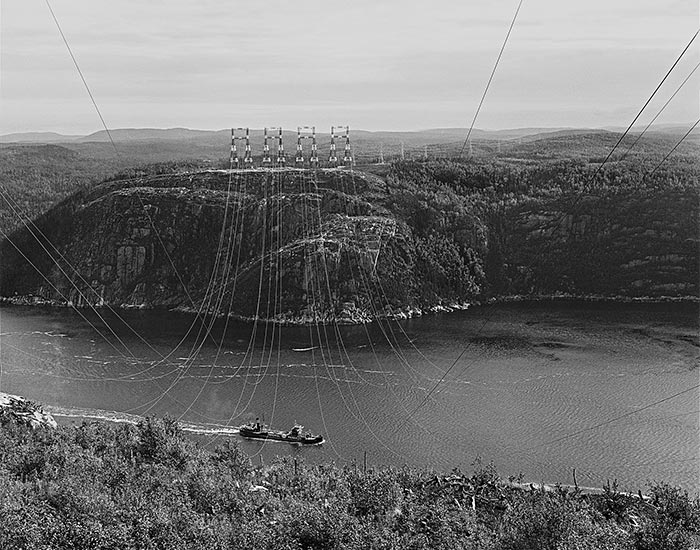1945-1959 – Hydro-Québec’s First Triumphs
The increase in demand for electricity was stimulated by post-war prosperity. Hydro-Québec set about improving the reliability of a transmission and distribution system that had been left in a deteriorated state by Montreal Light, Heat and Power. It continued construction of Beauharnois generating station and began work at its first remote site, on the Rivière Betsiamites (also known as Bersimis) in Québec’s Côte-Nord region. Betsiamites provided Hydro-Québec with an opportunity to gain expertise and show it could transmit power over long distances at the unprecedented voltage level of 315 kV. Hydro-Québec also undertook construction of Carillon generating station on the lower portion of the Rivière des Outaouais (Ottawa River). Throughout this period, at the request of Premier Maurice Duplessis, the utility gradually extended its territory beyond the Montréal area. However, when it came to the electrification of rural Québec, Duplessis preferred to give the task to the Rural Electrification Agency.
1945
Rural electrification by cooperatives
On May 24, under Premier Maurice Duplessis, the Rural Electrification Act was passed. Less interventionist than his predecessor, Adélard Godbout, who had entrusted electrification to Hydro-Québec, Duplessis preferred to leave it up to the local communities to bring electric power to Québec’s less densely populated regions, which were markets that held little appeal for private enterprise. Of the 46 electricity cooperatives that grew out of this law, 45 accepted Hydro-Québec’s 1963 buyout offer. Only one of the cooperatives, Saint-Jean-Baptiste-de-Rouville, still exists today.
Maurice Duplessis (1890-1959)
Opposed to any form of government intervention in the economy, Maurice Duplessis had taken a stand against the nationalization of Montreal Light, Heat and Power. Elected premier in June 1944, just a few weeks after Hydro-Québec’s inception, he was duty bound to complete the task undertaken by his predecessor, Adélard Godbout. To remain on a good footing with his electoral base in rural Québec, Duplessis created the Rural Electrification Agency. He also reassured the private power companies that under his government, there would be no further nationalization of electricity in Québec. This did not prevent the wily Duplessis from calling on Hydro-Québec to supply power to regions that were of little interest to private enterprise but had a pressing need for electricity to develop their timber and mineral resources.
Slide show
The following slide show contains images from the year 1945
1947
Compensation of Montreal Light, Heat and Power shareholders
A $112,225,000 bond issue replaced the bank loan Hydro-Québec had been forced to take out to compensate the shareholders of Montreal Light, Heat and Power Consolidated and its subsidiaries. The final settlement with the shareholders of the two subsidiaries—Beauharnois Light, Heat and Power and Montreal Island Power—did not occur until 1953, after long legal arbitration.

Montreal Light, Heat and Power Consolidated stock certificate. The Québec Hydro-Electric Commission presented a takeover bid to the company’s shareholders at the time of the 1944 nationalization.
Source: Hydro-Québec archives
1950
Strategic presence in Abitibi
At the behest of Premier Maurice Duplessis, Hydro-Québec acquired Rapide-7 generating station in Abitibi. The utility also undertook development of Rapide-2 on the upper Rivière des Outaouais (Ottawa River). These projects were intended to meet the mining industry's growing power needs. When Hydro-Québec acquired the private electricity distributors in 1963, it became the owner of the region's existing power stations and converted the distribution system frequency from 25 to 60 hertz.
Slide show
The following slide show contains images from the year 1950
1953
Betsiamites: First remote site and 315-kV lines
Hydro-Québec undertook to develop the Rivière Betsiamites (also called Bersimis) in the Côte-Nord region. This was a good chance for the company to learn about managing projects at remote work sites and acquire expertise in transmitting large quantities of energy over long distances; the distance to the Montréal market was over 600 kilometres. Hydro-Québec became one of the first electric utilities in the world to use 315-kV transmission lines. A remarkable undertaking for the time, the overhead 315-kV transmission lines crossed the Rivière Saguenay along a 1.6-km stretch.
Slide show
The following slide show contains images from the year 1953
1955
Boosting the economy of the Bas-Saint-Laurent region
The belated electrification of the Gaspé peninsula and the Bas-Saint-Laurent region was carried out under the aegis of the Compagnie de Pouvoir du Bas-Saint-Laurent. Mitis-1 and Mitis-2 did not have enough generating capacity to power the industrialization of the region. At the government’s request, Hydro-Québec laid an underwater cable between the Manicouagan peninsula and the village of Les Boules in the Gaspé region. This link allowed access to energy from the Côte-Nord region, but proved so unreliable that a backup thermal power plant had to be built. Subsequently, transmission lines were erected from Lévis to Gaspé to meet the region’s electricity needs.

Analog ammeter used by Compagnie de pouvoir du Bas-Saint-Laurent (1922–1963). The needle’s position on the dial indicates the intensity of the electric current in amperes.
Hydro-Québec historical collection
2004.0132
1959
Prelude to major technological feats
In the fall of 1959, Hydro-Québec announced the start of development of the Manicouagan and Outardes rivers in the Côte-Nord region (north shore of the Saint-Laurent). This huge undertaking would require the utility to perform a series of technological feats in the course of taming these northern rivers and transmitting high volumes of energy over several hundred kilometres to supply major consumer markets in the Québec and Montréal metropolitan regions. By the start of the 1960s, Hydro-Québec possessed enviable expertise in the generation, transmission and distribution of electric power. Since its beginnings, the company had expanded continuously without depending on government resources or needing to increase its rates. It was well positioned to take on a broader mandate. Hydro-Québec’s successes soon made it a symbol of the Quiet Revolution and earned it an international reputation.
Top of page









